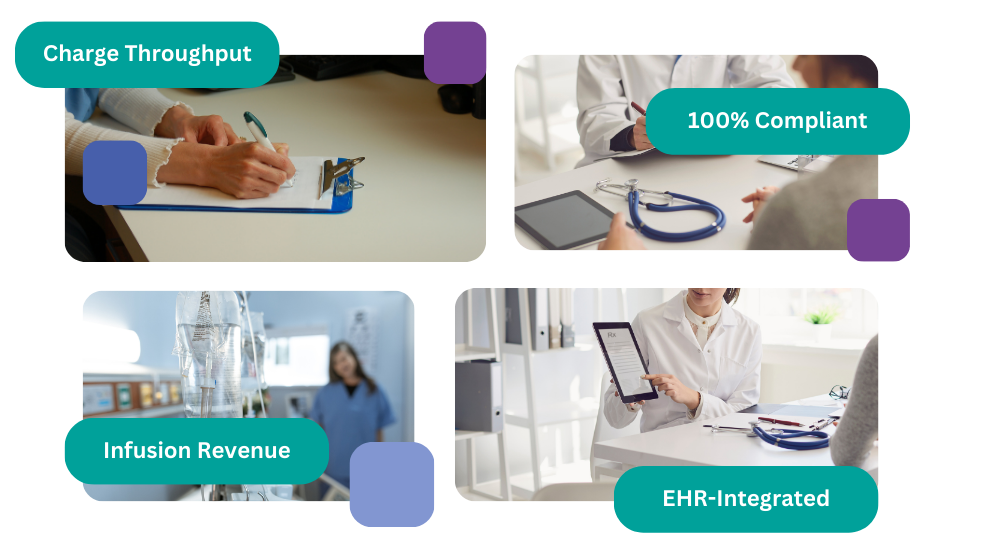Infusion Billing Logic
Automatically applying AMA and CMS rules for initial, subsequent, concurrent infusions, hydration, and injections.
Automate infusion medical billing to capture missed charges, maximize reimbursement, and protect your revenue cycle.

Infusion medical billing is one of the most complex and financially significant areas of the mid-revenue cycle. For outpatient infusion centers, emergency and oncology departments, and specialty clinics, the stakes are high - missing or misapplying codes and inaccurate start and stop times directly affect reimbursement, cash flow and compliance.
Despite this, manual workflows are still very common. Nurses hand-write start and stop times, coders manually interpret documentation, and finance teams piece together bills for multi-hour, multi-drug encounters. This patchwork increases the risk of missed charges, underbilling, or payer takebacks.
Moving to infusion coding automation optimizes how your organization handles:
Infusion Billing Logic
Automatically applying AMA and CMS rules for initial, subsequent, concurrent infusions, hydration, and injections.
Charge Capture
Linking real-time start/stop times, orders, and documentation to ensure complete outpatient charge capture.
Compliance Readiness
Producing clean claims that withstand payer scrutiny and reduce denials or clawbacks.
Cash Flow
Get paid faster by submitting more accurate claims the first time.
Take this quick diagnostic to see if your infusion billing processes could be leaking revenue:
If you answered yes to even one, your outpatient infusion center could be at risk for underbilling, delayed cash flow, or compliance challenges – making it worth exploring how automation strengthens your process.
Nurses manually record times, coders reconstruct later – often missing billable details.
Automated tools tie start/stop times to codes, reducing missed services.
Staff manually decide if it’s initial, subsequent, concurrent – leading to errors.
Software automatically applies hierarchy for maximum compliant reimbursement.
Incomplete links between documentation, orders, and charges.
Clear, defensible claims aligned with payer expectations.
Payment delays due to manual errors and rework.
Faster, cleaner claims with fewer rejections.
Frequent underbilling from uncertainty or skipped steps.
Confidence all provided services are captured and billed.
Recovered significant missed revenue through infusion coding automation, strengthening outpatient infusion reimbursement.
medaptus’ Charge Infusion software billing reduced the manual labor and the potential for billing errors for Banner Health. This resulted in Banner Health expanding the use of the solution to 19 more facilities and showing an impressive ROI.
Inpatient coding revolves around MS-DRGs tied to ICD-10-PCS procedures and diagnoses, bundling many services into a single payment. Outpatient infusion coding uses CPT/HCPCS codes billed line by line, requiring detailed service tracking and proper hierarchy. Learn more about typical outpatient pitfalls in our Outpatient Infusion Revenue Leakage Checklist.
Outpatient infusions are directly billed per service under fee schedules, which often results in separate charges to payers or patients. Inpatient infusions are usually wrapped into a DRG payment, which makes maximizing outpatient documentation and coding even more critical. See more in Part 2 on Outpatient Infusion Reimbursements.
Inpatients are primarily coded based on overall diagnoses and hospital stays. Outpatient services – like those in infusion centers – demand precise CPT-level coding for each therapy, start/stop times, and hierarchy logic.
Watch more in our video series:
Better infusion center software isn’t just about getting paid. It protects your financials while supporting your clinicians, patients, and compliance team.
When you’re ready to see how automation can improve outpatient charge capture and safeguard your margins, explore our Charge Infusion solution.
Subscribe to our newsletter today.